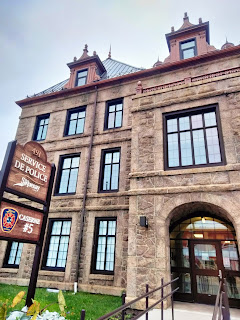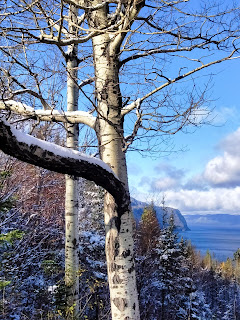“I think of Canada first and foremost in terms of space. The amount of space available is breath-taking.”
Ayaan Hirsi Ali
Saquenay,
Canada is a city in Saint-Jean region of Quebec that is mainly known
for Saguenay Fjord which goes into the St. Lawrence River. Saguenay
is about 120 miles north of Quebec City. This area had abundant
wilderness, a fjord, whales, an inland sea, and small but delicious
blueberries. Most people in this area speak French but many also
speak English.
On
the back to back cruise we were on to New England and Canada, we
would get to experience this city twice. On the first visit, we did
not book an excursion and decided to just walk around the town. As we
exited the cruise ship, we were enchanted with the people at the port
dressed in fancy clothes and faces painted. Some were standing on
stilts. There were jugglers, guys riding on bicycles, and even some
guys dressed in lumberjack outfits. One of the lumberjacks ran over
to me and gave me a stick with some maple syrup on it. We walked
over to wear they were heating up the maple syrup, then pouring it
directly onto fresh snow. It was delicious. The we walked in the port building and there was a unique tall statue greeting us.
We
started walking around this small town when we came upon a statue of
a cow painted blue with flowers standing on a cart with wheels. Then
we walked passed a beautiful church called Saint Alphonse Parish
Church and Presbyterian complex built in 1900. Father Henry Cimon
had the house next to the church built for his three sisters. This
church was established in 1857 and is one of the oldest parishes in
La Baie that is still in operation. The church was originally built
in 1885 and was designed by architect Victor Roy. It was later
donated to the city.
Then
we saw Tim Horton’s, aka Tim’s or Timmie’s, for a cup of
coffee and tea. It is known as being the home of Canada’s
favorite coffee and is also Canada’s largest quick service
restaurant chain. They serve donuts, sandwiches, and other fast food
items. We met up with many fellow cruisers at that stop.
From
there, we spotted a large a large church in the distance and decided
to head towards it to check it our. On the way, we passed a couple
of antique cars parked along a building. We walked down a hill and
then crossed over a bridge spanning a river. It was a very cold day
and the wind made it feel even colder. Before we got to the church,
we walked passed the Old Port-Alfred Town Hall which was designed by
architects, Lamontagne Gravel and Brassard and was designed after
the Quebec City court house. It is a four story French style brick
building with a clock tower. This building has been used as a fire
station, post office, town council office, municipal services,
library, telephone and telegraph and customs office.
Then
we came to St. Edward Presbyterian Church. This beautiful church was
not open but was gorgeous from the outside. It was build in a
thirteenth-century English style and built during the years of
1925-1928. The church and grounds are beautiful. That is when we
saw the For Sale sign. Wow. That was unusual.
From
there we crossed the street to a park. Then we headed pass the Ha Ha
Bay Sulphite Company. We then found a walking and biking trail back
towards the ship. We walked by mud flats and saw an interesting
fenced area in the mud. We found out that is used for spawning
Rainbow Smelts. He raved about the flavor and said the locals here
love it. I kind of chuckled as when I was a little girl, we had
smelts a lot as this fish was very inexpensive. All my brothers and
sister, got to where we couldn’t stand it. I wonder if his Rainbow
Smelts were better than the ones we got at home in New Jersey.
Since
the town was pretty much closed up that day, we kept it short and got
back on the ship.
On
our next visit about three days later, we had scheduled an excursion
through Viator called Back Country of the Fjord and the National
Park. Once again, as we left the ship, our fancy people greeted us
again. It was freezing and had snowed but they still braved the
weather to come and welcome us. Once again I got one of the
delicious maple syrup sticks made by the lumberjacks. It was snowing
and we were very excited as living in Georgia, we do not get much of
a chance to see snow. We found our bus, just outside the port and it
was a 15 seat bus.
Our
tour guide was bilingual but French was his main language. He did a
good job with telling us about the area. Our journey started with us
passing by the monument that was a memorial to all those lost in the
flood of 1996 where most of the town got washed away. This monument
is called the Ha! Ha! Monument, named after the Ha! Ha! River and is
a pyramid shaped monument that stands 69 feet high. It is made out
of 3,000 yield signs. The yield signs in French means to help each
other. They built this monument as a form of therapy for the people
who were lost in the flood as well as their homes. Ten people died
in this flood and between 12,000 and 16,000 residents were displaced
as 500 – 800 buildings were destroyed. Inside the monument there
are engraved plaques with local family names that were affected by
the flood. We passed one house that survived and they put a memorial
to Christ outside his home as a thanks and praise to God for allowing
the house to survive.
The
bus stopped at a statue that memorialized a man who helped to plant
trees and get the lumber business going in this area.
We
started heading north driving for quite a while till we came to the
Village de Creche in Riviere-Eternite, Quebec. We stopped at this
unique area with many religious statues nativity scenes and religious
statues in an outdoor exhibit. This was an interesting stop with
some very pretty statues by different artist that were snow covered
all along this 300 yard path. The statues were made out of wood,
plastic, or metal. In this area there was at least four inches of
snow and it was just beautiful looking up at all the snow covered
pines.
Then
our bus headed into Saguenay Fjord National Park where we saw amazing
views of the Fjord. This fjord has an average depth of 690 feet to
its deepest point at 890 feet. The park was created in 1983. The
snow was a lot deeper here and the pine branches were heavy with
snow. It looked beautiful. We were not quite prepared for snow and
we were in sneakers. We had forgotten how it sounded walking in the
snow. That old familiar crunching sound we heard in years past
playing in the snow. We also forgot how cold our feet and toes would
get.
The
Fjord is both salt water and fresh water. The first couple feet is
fresh water so it freezes over in the winter. Our guide said that
after the fjord freezes, it becomes a little city as people bring
their trailers and set them up on the ice for ice fishing right in
the town of Saguenay. He said it used to be hap hazard with where
they put their trailers but now, they actually make streets and are
very organized. People come from all over to fish.
The L'Anse - Saint - Jean Covered Bridge and town was a lovely stop in this quaint village. The wooden covered bridge was built in 1926 but has washed away twice. It spans the St. Jean River. The inside of the bridge has artwork from local artist displayed. This was a great picturesque stop.
On
the way back to the boat, we stopped at a grocery store where they
sold sandwiches, snacks, and hot drinks. That was just what we
needed. Then it was back to the ship. What a great tour. We never
would have suspected that we would be seeing snow on this trip but we
were not disappointed at all. In fact, we were thrilled. It was a
nice bonus. What a great day.
Till
next time. Bye for now.









































































































































